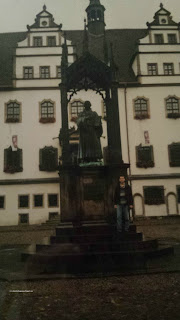This blog is my attempt to remember and share a little bit (= ein kleines bisschen) about my German heritage: daily life, culture, vocabulary, history, and cooking.
I taught high school German I & II for 4 years at a small, Christian school.
My students called me "The Frau*".
Wilkommen to my new blog!
(*Frau is the German word for woman, as well as the address for Mrs.)
When one travels or is a visitor, they are often asked, "Where are you from?". To make things simple, I usually answer, "Tennessee" because that's where my parents live now and where I spent my life from 6th grade - and other than 1 year diversion to another state - through college graduation. East Tennessee is kind of "home" even though I've lived many places since then.
But in reality, I am ORIGINALLY from Germany. I was born in Frankfurt in the early 1970s in a district called Ginnheim, which is to the north of the city center.
The main identifier of the district is its TV tower, also known as the Europaturm (Europe Tower), which was opened in 1979. It is nicknamed the Spargel (asparagus) of Ginnheim. I am old enough to remember Ginnheim BEFORE this 2nd tallest TV tower in Germany was constructed (the tallest is in Berlin)!! It is 337.5 meters high (that's about 1,107 feet) and has become rather obsolete - unfortunately - these days due to new satellite technology; its observation deck and rotating restaurant are closed to public, last I heard.
(Ginnheimer Spargel seen from the Nidda River)
As a child, it was just normal for me to ride my bicycle along the Nidda River, a tributary of the Main, which is the distinguishing river of the city. There are actually 2 Frankfurts in Germany - Frankfurt am Main and Frankfurt an der Oder (on the Oder River), which is in eastern Germany.
(the Main River as seen from Sachsenhausen district)
My Opa (Grandfather)'s family on my mother's side was from the Frankfurt area, and my Oma (Grandmother's) family was from East Prussia. World War II brought them together as they were married in Prussia in October of 1942. My Oma was a farm girl - or at least a country girl. My Opa was from the big city. It is amazing to me to think neither of them ever owned an automobile, and my Opa only ever had a short stint as a motorcycle owner (until he wrecked!). As city dwellers, they could get anywhere they needed to go on foot, by public transportation, bicycle, train, or with a taxi. Occasionally, a relative or friend would also give them a ride.
A kind of ironic situation happened to my Opa in the time after the war, when Germans were desperate for jobs. My Opa took a job as a streetcar conductor. However, he found that after a long day on the rails, he would become quite motion sick! So, he had to give up that job. In the end, he got a job as a Beamter (Civil employee), I believe, with the German Postal System (Bundespost), which is a federally run institution in Germany, founded in 1950. Previously, it had been the Reichspost (the imperial post office) until 1945 (and was run by the Allies in the interim). As a child, I remember the local post office was always completely closed for lunch time - as was the bank in town as well as other businesses.
Because my grandparents enjoyed having a garden patch, another part of my childhood was going to their little garden almost daily. To be a part of a Kleingarten Verein (small garden club) was not unusual for city folks. It was a place for those who lived in apartments, as my grandparents did, to have a little bit of green - some grass, flower and vegetable beds, and in our case, a little garden hut or cottage for parties or even an overnighter.

(picture: my Oma and me at the cottage at the Kleingarten Verien, ca. late 1970s)
My grandparents' garden club was part of a Kanninchen Zucht Verein (rabbit breeding club), which featured a rabbit exhibition each summer. My Opa always had 4 to 8 rabbits. On our almost-daily walks and bicycle rides, we often paused to pick Löwenzahn (dandelion) leaves as a treat for the bunnies!
VOCAB TIDBIT:
Löwenzahn is made up of 2 German words: Löwe = lion and Zahn = tooth. No doubt this is a description of the jagged edges of the dandelion leaf.
(picture source: botanical.com)
Another of my favorite plant compound words in German is Löwenmaul: Maul = mouth (of an animal). The word Maul is different than the word Mund, which is the German word for a human mouth. Löwenmaul is a snapdragon.
(picture source: google images)
But for today, I will say Auf Wiedersehen. (Auf wiedersehen is not really good-bye, but a German wish to see another again - wieder = again; sehen = to see.)
This is a small glimpse of what I hope my blog will continue to be - ein bisschen THIS and ein bisschen THAT.



















